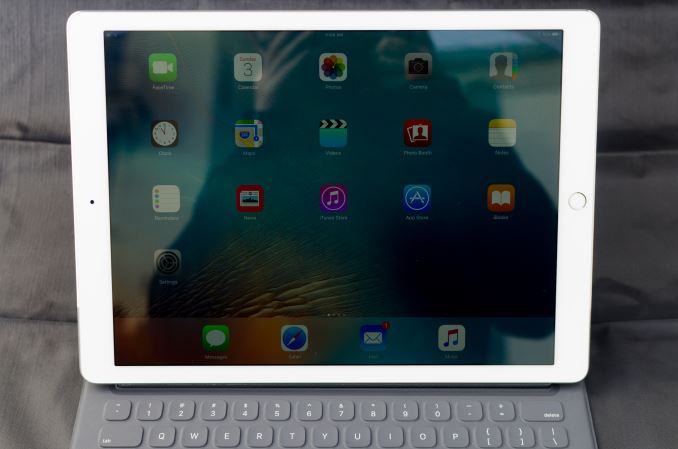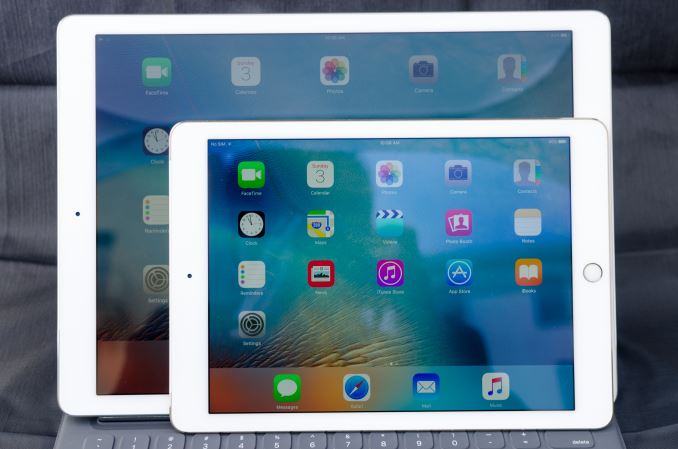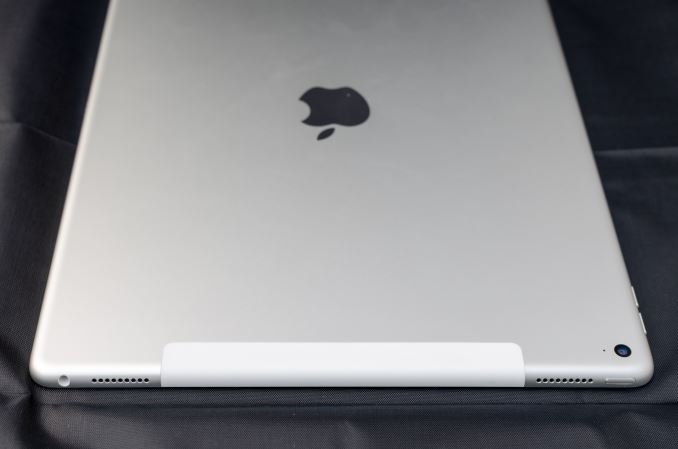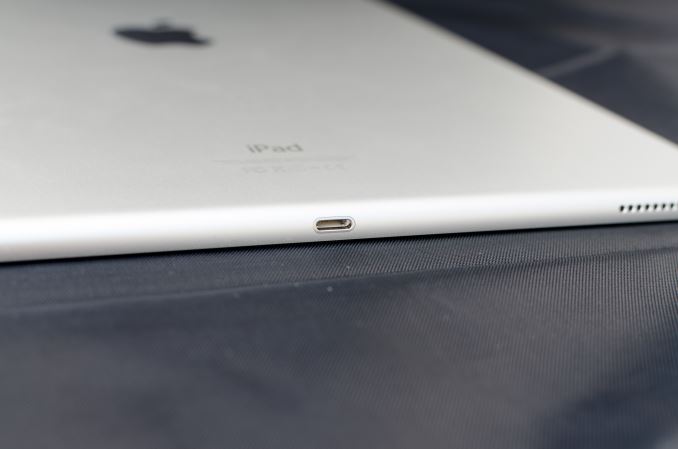The Apple iPad Pro Review
by Ryan Smith, Joshua Ho & Brandon Chester on January 22, 2016 8:10 AM EST
At this point it probably isn’t a secret that tablet sales have leveled off, and in some cases they have declined. Pretty much anywhere you care to look you’ll see evidence that the tablet market just isn’t as strong as it once was. It’s undeniable that touch-only tablets have utility, but it seems that the broader market has been rather lukewarm about tablets. I suspect at least part of the problem here is that the rise of the phablet has supplanted small tablets. Large tablets are nice to have, but almost feel like a luxury good when they’re about as portable as an ultrabook. While a compact laptop can’t easily be used while standing, or any number of other situations where a tablet is going to be better, a compact laptop can do pretty much anything a touch-only tablet can. A laptop is also going to be clearly superior for a significant number of cases, such as typing or precise pointing.
As a result, large touch-only tablets feel like they’ve been limited to home use as a computer away from the computer. Tablets are great when you’re on the couch or in bed, but once you get to this point there are some obvious questions as to whether it makes sense to drop $500+ USD on a tablet that seems to have relatively limited utility. The Surface lineup has been showing signs of growth, but in general the Surface is more of a mix between laptop and tablet rather than a tablet. I would argue that given the OS and overall design that the Surface and Surface Pro are really more laptop than tablet, even if at the hardware level the Surface Pro 4 and Surface 3 are basically tablets with kickstands and keyboard covers.
If you’re guessing that this means Apple has had some issues with growing sales of their iPad lineup, you’d be right. From my first experiences with the iPad 3, I was impressed with the improved user experience for things like web browsing and other smartphone tasks, but I never really felt like it made enough sense to get one for myself. The iPad Air 2 was once again impressive and I felt like I could recommend it to other people that wanted a tablet, but I personally struggled to come up with a reason why I would buy it.
This brings us to the iPad Pro. This is probably the first time Apple has seriously deviated from traditional iPad launches, putting together a tablet built for (limited) productivity and content creation rather than just simple content consumption, creating what's arguably the iPad answer to the Surface Pro. To accomplish this, Apple has increased the display size to something closer to that of a laptop, and we see the addition of a stylus and a keyboard cover for additional precision inputs. Of course, under the hood there have been a lot of changes as well, so the usual spec sheet can be found below to summarize those changes.
| Apple iPad Air 2 | Apple iPad Pro | |
| SoC | Apple A8X 3 x Apple Typhoon @ 1.5GHz |
Apple A9X 2 x Apple Twister @ 2.2GHz |
| GPU | PowerVR 8 Cluster Series6XT (Apple GXA6850) |
PowerVR 12 Cluster Series7XT |
| RAM | 2GB LPDDR3 | 4GB LPDDR4 |
| NAND | 16/64/128GB | 32/128GB |
| Display | 9.7" 2048x1536 IPS LCD | 12.9" 2732x2048 IPS LCD |
| Size and Mass | 240 x 169.5 x 6.1mm 437g WiFi, 444g LTE |
305.7 x 220.6 x 6.9 mm 713g WiFi, 723g LTE |
| Camera | 8MP Rear-Facing, f/2.4, 1.1 micron, 1.2MP Front-Facing, f/2.2 | |
| Battery | 27.3Wh | 38.5Wh |
| Launch OS | iOS 8 | iOS 9 |
| Cellular Connectivity | MDM9x25 Category 4 LTE + GPS/GNSS in Cellular SKU | |
| Other Connectivity | 2x2 802.11a/b/g/n/ac + BT 4.2, Apple Lightning | |
| SIM | Optional NanoSIM | |
| Price | $499/599/699 16/64/128GB | $799/949/1079 32/128GB/128GB LTE |
At a high level, the iPad Pro gains a larger display with a higher resolution, more memory, a new SoC, and a larger battery to compensate for the change in display size. In addition to these changes, the iPad Pro also brings noticeable changes to the speakers, with an increase to four speakers which allow the iPad Pro to compensate for device orientation when projecting stereo audio.
Design
The most immediate change that you can see in the iPad Pro is the sheer size. The 12.9” display of the iPad Pro basically makes it feel like you’re carrying a laptop around. I would argue that this doesn’t actually affect the portability of the iPad Pro, but this is mostly because the iPad Air 2 was something that I only carried in a backpack to begin with. People carrying their tablets in a small bag, purse, or even just in their hands will notice the difference, so the change in size might be more or less noticeable depending upon how you carry things around.
The increase in size does affect weight. After significant use, I honestly don’t think the mass is a significant issue. It does feel heavier than the iPad Air 2, but the mass distribution is such that there isn’t a ton of battery hanging out at the edges of the device where it’ll affect the moment of inertia. This does raise the question of whether Apple included enough battery for sufficient battery life, but that’s a question best left for the rest of the review.
In terms of design, the iPad Pro is rather unremarkable if you’ve ever seen an iPad Air before; it is for all intents and purposes a bigger iPad Air. On the front, the display dominates, with some bezels on the sides and top. The top has the front-facing camera, and the bottom has the home button with TouchID.
Looking at the sides of the tablet, the top edge has the power button and 3.5mm port, along with two of the four speakers. The right edge has the volume buttons, and the bottom edge has the Lightning port and the other two speakers. The left edge is mostly empty, but contains the Smart Connector for the Smart Keyboard and similar accessories.
The back of the tablet is mostly unremarkable as well. For the LTE model, an RF window is visible on the top of the device to allow LTE and other connectivity to function. For the WiFi variants, it looks like the bottom display bezel and the bottom two speakers are the RF windows, so there aren’t any visible areas that indicate where the WiFi antennas are.
Overall, the iPad Pro feels like an iPad, with nothing all that remarkable beyond its size which is carried well. I never really noticed the mass or size of the iPad Pro even if it is clearly larger and heavier than the iPad Air 2. I also didn’t notice any issues with the back cover flexing, but given enough pressure on the back cover pretty much any device this large will see some screen distortion or bending. The iPad Pro does technically regress in thickness compared to the iPad Air 2, but I never noticed the difference in practice, especially when the larger display is really what matters more.
















408 Comments
View All Comments
xerandin - Saturday, January 23, 2016 - link
In what way did Microsoft saw Surface Pro parts off of other products? You know what's better than that "most stable, secure, and highest quality mobile OS?" For most people, that would be Microsoft Windows--even if they love to complain about it, you can't deny Microsoft's ubiquity in the Professional space (and home userspace, too, but we're trying to keep this in the professional sector, right?)I've heard a few people at work say that the sysadmins love Macs (it was a Director obsessed with his Macbook telling me this), but I can't seem to find any of these supposed Mac-lovers. It could have something to do that they're a nightmare to administer for most sysadmins running a domain (which covers the vast majority of sysadmins), or the fact that Mac users tend to be just as inept and incapable as Windows users, so you get to have another pain-in-the-ass group of users to deal with on a system that just isn't very nice to administer.
If you take off your hipster glasses for a moment and actually use computers in the world we live in, there's no way around the reality that Microsoft wins in the Professional space--including their beautifully made, super-powerful Surface Pro.
And no, I'm not a Microsoft shill, I just can't stand Apple fanboys with more money than sense.
gistya - Sunday, January 24, 2016 - link
Xerandin, you have no idea what you are talking about. 90% of the professional software development studios I work with are almost solely Mac based, for the simple reason that they barely need an IT department at all, in that case.Windows is technical debt, plain and simple. It's legacy cruft stuck to the face of the world. The only IT guys that hate Macs are the idiot ones who don't know bash from tsch and couldn't sudo themselves out of a wet paper box. Then there are the smart ones who know that a shift to such a low maintenance platform would mean their department would get downsized.
But so many companies are stuck on crap like SAP, NovellNetware, etc., that Microsoft could literally do nothing right for 10 years and still be a powerhouse. Oh wait.
Apple hardware is worth every extra cent it costs, and then some; if you make such little money that $500 more on a tool that you'll professionally use 8-12 hours a day for three years is a deal-breaker, then I feel very sorry for you.
But personally I think it's more than worth it to have the (by far) best screen, trackpad, keyboard, case, input drivers, and selection of operating systems. I have five different OS's installed right now including three different versions of windows (the good one, and then the most recent one, and the one that my last job still uses, which does not receive security patches and gets infected with viruses after being on a website for 10 seconds).
As for the iPad Pro, all of you fools just don't understand what it is, or why the pencil is always sold out everywhere, or what the difference is. As a software developer I can tell you that there is the most extreme difference; and that more development for iOS is being done now than ever before, and is being done at an accelerating pace. This is just version 1.0 of the large-size, pro type model for Apple, and those of us who did not buy it yet and who are still waiting for that killer app, are basically saying that well, once that app comes out, then heck yes we'll buy it. Do you seriously believe that no company will rise up to capitalize on that obviously large market? Someone will, and frankly lets hope it's not Adobe.
I regularly see iPad pros now in the hands of the professional musicians and producers I work with, and they are most certainly using them for professional applications. That's a niche to be sure, but everyone who thinks that the surface pro 4 (a mildly crappy laptop with a touchscreen that makes a bad, thick tablet and an underpowered, overheated laptop) is even remotely in the same category of device, is utterly smoking crack.
doggface - Sunday, January 24, 2016 - link
I think it might be you smoking the crack there mate. Cor, what a rant. Microsoft are pretty safe in enterprise and it has everything to do with managing large networks(1000s not 10s of computers.. Please, direct me to Apple's answer to sccm, please show me Apple's answer to exchange. Please show me an Apple only environment running 1000 different apps outside ofGoogle and Apple HQ. Just aint haopening.Constructor - Sunday, January 24, 2016 - link
IBM (yes, the IBM!) has just announced that they will switch over to Macs a while ago. And they're neither the first nor the last. Springer (a major german media company) had done that a while ago already for similar reasons (removing unproductive friction and cutting the actual cost of ownership due to less needed user support).I know that many people had imagined that Windows would be the only platform anyone would ever need to know, but that has always just been an illusion.
damianrobertjones - Monday, January 25, 2016 - link
Link to the article please! They're THINKING of using Apple for mobile use... .Constructor - Monday, January 25, 2016 - link
Nope. They're massively ramping up Mac purchases as well, with a target of 50-75% Macs at IBM. They are already full steam ahead with it:http://www.i4u.com/2015/08/93776/ibm-purchase-2000...
(Okay: The official announcements don't have that aspect, but an internal video interview with IBM's CIO leaked to YouTube makes it rather explicit even so.)
One of the motivators is apparently that despite higher sticker prices the total cost of ownership is lower for Macs (which is not news any more, but having IBM arriving at that conclusion still says something).
Oxford Guy - Wednesday, January 27, 2016 - link
Gartner said in 1999 that Macs were substantially cheaper in TCO.mcrispin - Tuesday, January 26, 2016 - link
doggface, you speak with confidence where that confidence isn't deserved. I've managed deployments of OS X way over 10k, there are plenty of places with deployments this high. JAMF Casper Suite is the "SCCM of Apple", I don't need an "Apple" replacement for Exchange, 0365 and Google are just fine for email. There are plenty of non-Apple/Google Apps for OS X and iOS. You are seriously misinformed about the reality of the OS X marketplace. Shame that.Ratman6161 - Wednesday, January 27, 2016 - link
mcrispin...sure you can find individual shops that have done big MAC deployments. but its anecdotal evidence. Its like looking at one neigborhood in my city and from that conclude that trailer parks are the norm in my city of 15,000.Take a look at this Oct 2015 article on Mac market share (I'm assuming you dont consider Apple Insider to be a bunch of Microsoft shills?) http://appleinsider.com/articles/15/10/08/mac-gain...
While touting how Mac is gaining market share they show a chart where in Q32015 they were at 7.6%. The chart is by company and even smaller Windows PC vendors Asus and Acer are at 7.1 and 7.4 respectively. Throw in Lenovo, HP and Dell at 20.3%, 18.5%, 13.8% and the 25.3% "others" (and others are not MAC's because Apple is the only company with those).
So IBM is doing 50 - 75% Mac's? OK Ill take your word for that but so what? In the larger scheme of things Apple still has only 7.6% and selling some computers to IBM isn't going to siginificantly change that number. Also, don't forgot that some companies (that compete with Microsoft in various areas) will not use a Microsoft product no mater how good it was.
No matter how you look at it, Windows is the main stream OS for busineses world wide. Touting the exceptions to that doesn't cange the truth of it.
Constructor - Wednesday, January 27, 2016 - link
Of course most workplace computers now are PCs. The thing is just that Macs are making major inroads there as well.$25 billion in Apple's corporate sales are already very far removed from your theory (and that's even without all the smaller shops who are buing retail!).